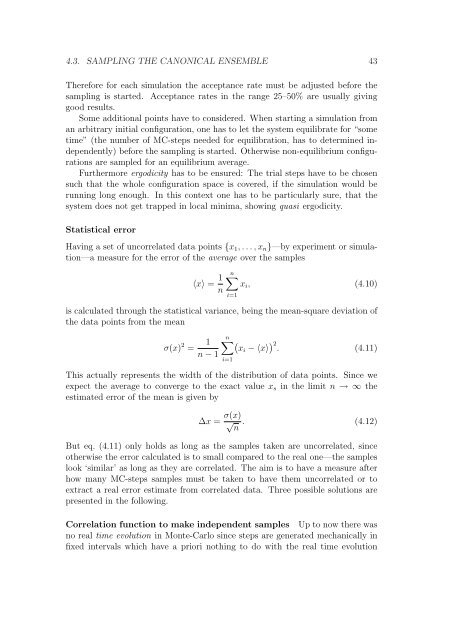Polymers in Confined Geometry.pdf
Polymers in Confined Geometry.pdf
Polymers in Confined Geometry.pdf
Create successful ePaper yourself
Turn your PDF publications into a flip-book with our unique Google optimized e-Paper software.
4.3. SAMPLING THE CANONICAL ENSEMBLE 43<br />
Therefore for each simulation the acceptance rate must be adjusted before the<br />
sampl<strong>in</strong>g is started. Acceptance rates <strong>in</strong> the range 25–50% are usually giv<strong>in</strong>g<br />
good results.<br />
Some additional po<strong>in</strong>ts have to considered. When start<strong>in</strong>g a simulation from<br />
an arbitrary <strong>in</strong>itial configuration, one has to let the system equilibrate for “some<br />
time” (the number of MC-steps needed for equilibration, has to determ<strong>in</strong>ed <strong>in</strong>dependently)<br />
before the sampl<strong>in</strong>g is started. Otherwise non-equilibrium configurations<br />
are sampled for an equilibrium average.<br />
Furthermore ergodicity has to be ensured: The trial steps have to be chosen<br />
such that the whole configuration space is covered, if the simulation would be<br />
runn<strong>in</strong>g long enough. In this context one has to be particularly sure, that the<br />
system does not get trapped <strong>in</strong> local m<strong>in</strong>ima, show<strong>in</strong>g quasi ergodicity.<br />
Statistical error<br />
Hav<strong>in</strong>g a set of uncorrelated data po<strong>in</strong>ts {x1, . . . , xn}—by experiment or simulation—a<br />
measure for the error of the average over the samples<br />
〈x〉 = 1<br />
n<br />
n<br />
xi, (4.10)<br />
is calculated through the statistical variance, be<strong>in</strong>g the mean-square deviation of<br />
the data po<strong>in</strong>ts from the mean<br />
σ(x) 2 = 1<br />
n − 1<br />
i=1<br />
n <br />
xi − 〈x〉 2 . (4.11)<br />
This actually represents the width of the distribution of data po<strong>in</strong>ts. S<strong>in</strong>ce we<br />
expect the average to converge to the exact value xs <strong>in</strong> the limit n → ∞ the<br />
estimated error of the mean is given by<br />
i=1<br />
∆x = σ(x)<br />
√ n . (4.12)<br />
But eq. (4.11) only holds as long as the samples taken are uncorrelated, s<strong>in</strong>ce<br />
otherwise the error calculated is to small compared to the real one—the samples<br />
look ‘similar’ as long as they are correlated. The aim is to have a measure after<br />
how many MC-steps samples must be taken to have them uncorrelated or to<br />
extract a real error estimate from correlated data. Three possible solutions are<br />
presented <strong>in</strong> the follow<strong>in</strong>g.<br />
Correlation function to make <strong>in</strong>dependent samples Up to now there was<br />
no real time evolution <strong>in</strong> Monte-Carlo s<strong>in</strong>ce steps are generated mechanically <strong>in</strong><br />
fixed <strong>in</strong>tervals which have a priori noth<strong>in</strong>g to do with the real time evolution













